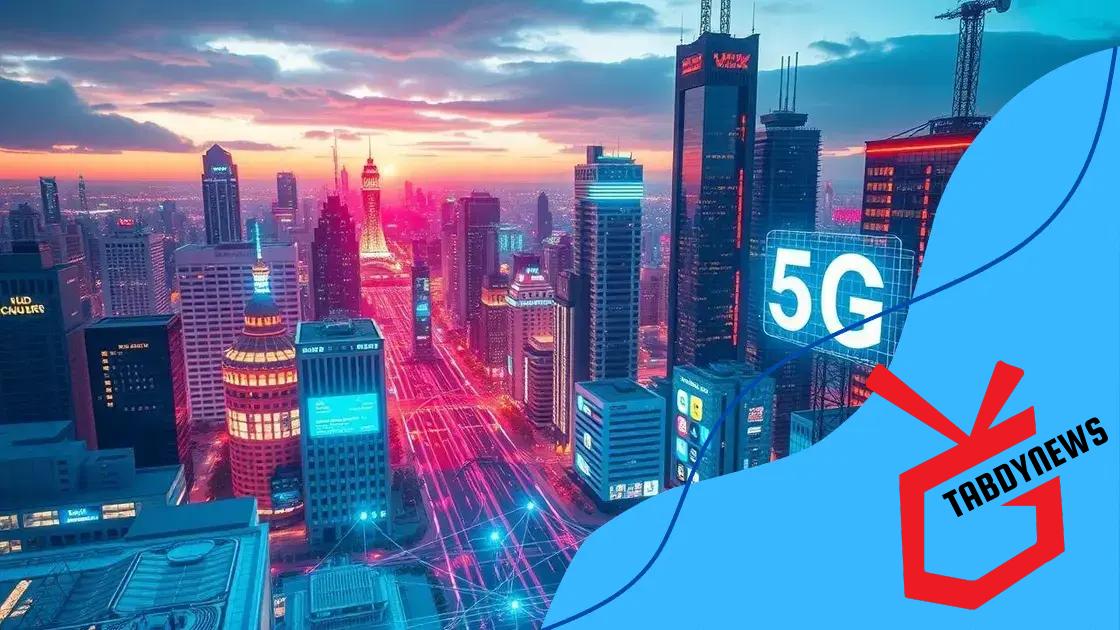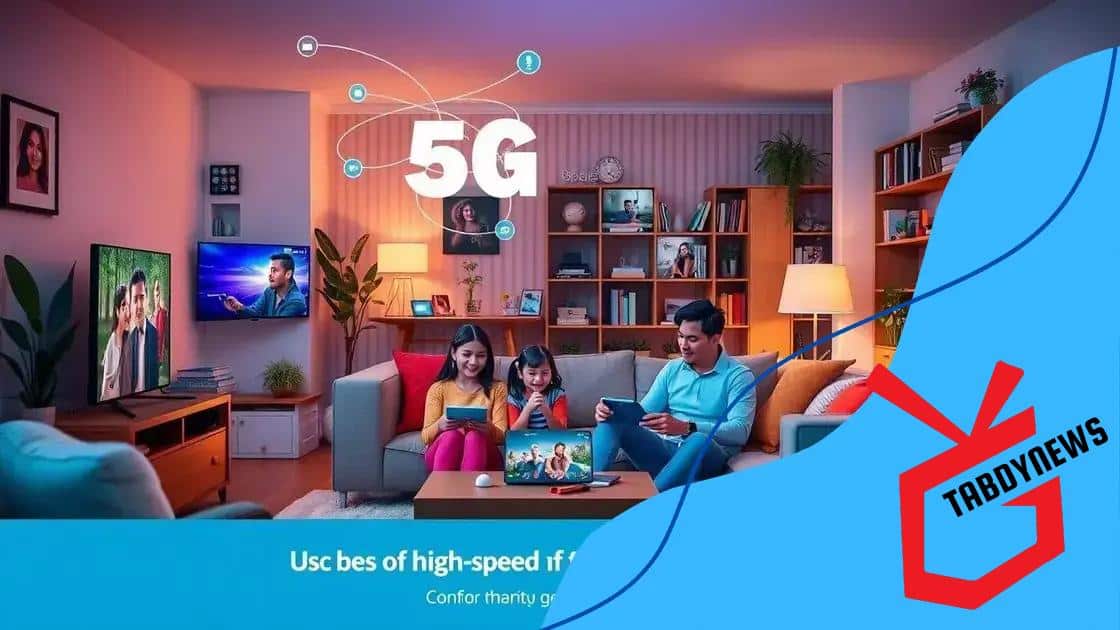5G’s impact on telecommunication infrastructure

5G significantly impacts telecommunication infrastructure by enhancing speed, connectivity, and service quality while introducing challenges such as infrastructure upgrades, regulatory issues, and security concerns.
5G’s impact on telecommunication infrastructure is profound, reshaping how we connect and communicate. Have you ever wondered how this new wave of technology can enhance your daily life? Let’s dive in!
Understanding 5G technology
Understanding 5G technology is essential in today’s rapidly advancing digital landscape. As we move towards a more connected world, this technology promises to enhance our communication experiences significantly.
5G stands for fifth-generation wireless technology, and it is a term we hear often. One key feature of 5G is its speed. Compared to its predecessor, 4G, 5G offers much faster download and upload speeds. Imagine downloading a movie in seconds rather than minutes. This capability will transform how we interact with mobile devices.
Key Features of 5G
Let’s explore the main features of 5G:
- Increased Speed: With speeds up to 100 times faster than 4G, 5G redefines possibilities.
- Lower Latency: The lag time will decrease significantly, making real-time communication seamless.
- Enhanced Capacity: 5G can connect many more devices at once, enhancing smart city technologies.
Another critical advantage of 5G is its improved connectivity. With more devices connecting to the internet, the infrastructure must evolve. 5G networks can handle this influx efficiently and effectively. This tech is not just about speed; it’s also about reliability and consistency.
Moreover, 5G empowers the Internet of Things (IoT), where everyday devices can communicate online. This integration opens doors to endless opportunities, from smart homes to smart transportation systems. Imagine your refrigerator notifying you when it’s time to buy groceries!
As 5G continues to roll out across the globe, we must embrace its potential. Understanding 5G technology will prepare us for the exciting future that lies ahead. The impact on industries like healthcare, transportation, and entertainment will be profound as we unlock new possibilities.
Key changes in infrastructure
The advent of 5G technology brings with it key changes in infrastructure that are transforming the telecommunications landscape. These changes not only enhance speed and connectivity but also require a complete overhaul of existing systems.
One major shift is the increase in the number of cell towers. Unlike 4G, which could serve larger areas with fewer towers, 5G requires many more small cells to provide consistent service. These small cells are often placed closer to users to ensure optimal coverage and speed.
Urban Planning and Design
As cities adapt, urban planning is evolving to accommodate more 5G infrastructure. This includes:
- Smart streetlights: Equipped with sensors and connectivity to enhance energy efficiency and data collection.
- Public Wi-Fi networks: Areas are establishing free Wi-Fi zones powered by 5G for residents and visitors.
- Smart traffic management: Using real-time data to control traffic flows and reduce congestion.
Another crucial aspect is the upgrade of existing fiber-optic cable systems. These cables are the backbone of 5G networks, providing the necessary bandwidth to support the high-speed requirements. The transition to 5G also means that service providers are investing heavily in improving and expanding their fiber networks.
In addition to physical infrastructure, network architecture is changing significantly. Edge computing is becoming more prevalent, allowing data processing closer to the source. This reduces latency, making applications like augmented reality and autonomous vehicles feasible in real-time. Overall, the shift towards 5G is not just about speed; it’s reshaping how we think about connectivity and infrastructure.
Benefits of 5G for consumers

The rollout of 5G technology offers numerous benefits for consumers that can significantly enhance daily activities. With a focus on speed, reliability, and connectivity, consumers stand to gain immensely from this technological evolution.
One prominent advantage of 5G is its incredible speed. With download rates up to 100 times faster than 4G, consumers can stream movies, download large files, and enjoy gaming experiences without lag. This speed also allows for smoother video calls and improved collaboration for remote work.
Enhanced Connectivity
5G also brings about enhanced connectivity. With the ability to connect many more devices simultaneously, consumers can enjoy a seamless smart home experience. Imagine controlling multiple gadgets from your smartphone without any slowdowns. This capability supports the growing demand for smart appliances and connected devices.
- Improved Streaming Quality: 5G allows for ultra-high-definition (UHD) video streaming, enhancing viewing experiences.
- Faster App Performance: Apps will load quickly, and data-intensive applications will run efficiently.
- More Reliable Connections: Fewer dropped connections mean seamless communication whether at home or on the go.
In addition to speed and connectivity, 5G opens up possibilities for new technologies and services. For example, consumers can access augmented reality (AR) and virtual reality (VR) experiences with minimal delay. This advancement could transform gaming, education, and even real estate by allowing virtual tours of properties.
Moreover, the reduced latency of 5G means that real-time applications, such as telemedicine and online gaming, will become more reliable. This advancement is particularly crucial for essential services like healthcare, where timely information and response can be life-saving.
Challenges in implementing 5G
While the rollout of 5G brings many advantages, there are also significant challenges in implementing 5G technology. These challenges can affect deployment timelines and overall effectiveness.
One major hurdle is the infrastructure upgrade that companies must undertake. Existing networks need to be updated to support 5G technology. This involves installing more cell towers and upgrading fiber-optic lines, which can be both time-consuming and costly.
Regulatory Hurdles
Another challenge comes from regulations. Local governments have different requirements for installing new technology, which can slow down the process. Coordinating with multiple stakeholders can complicate the rollout.
- Permitting delays: Acquiring the necessary permits can take longer than expected.
- Public opposition: Communities may resist new installations due to aesthetic concerns or misinformation about health risks.
- Lack of standardization: Different regions may adopt various technologies, complicating compatibility.
Moreover, establishing security measures for 5G networks is critical. With more devices connected to the internet, the potential for cyberattacks increases. Companies must invest in robust security systems to protect user data.
Finally, the economic aspect cannot be ignored. Investments in 5G are substantial. Telecom companies must balance their budgets while delivering top-notch service. This financial pressure can slow down the pace of deployment in some areas.
Future trends in telecommunications
The future of telecommunications is evolving rapidly, driven by technology advancements and changing consumer needs. Future trends in telecommunications promise to reshape how we communicate, work, and connect with the world around us.
One emerging trend is the integration of artificial intelligence (AI) into telecommunications networks. AI can help optimize network performance, manage traffic, and improve customer service. For instance, AI-driven chatbots can assist customers at any time, providing quicker solutions to common issues.
Expansion of IoT
Another significant trend is the expansion of the Internet of Things (IoT). More devices will connect to the internet, enhancing everyday life. From smart refrigerators to connected cars, IoT will allow for greater automation and convenience in our homes. This growth will require robust telecommunications infrastructure to support the surge in data traffic.
- Smart cities: Urban areas will adopt IoT technology for improved energy efficiency, public safety, and transportation management.
- Wearable technology: Devices like smartwatches will become increasingly popular, offering health tracking and communication features.
- Home automation: More households will use smart devices, from lighting systems to security cameras, enhancing living standards.
The implementation of edge computing is also on the rise. By processing data closer to its source, edge computing reduces latency and maximizes network efficiency. This advancement is particularly beneficial for real-time applications, such as autonomous vehicles and remote surgery.
Moreover, sustainable practices are becoming critical. The telecommunications industry is focusing on reducing its carbon footprint and finding eco-friendly solutions. This trend will continue as consumers become more environmentally conscious, demanding greener technology.
FAQ – Frequently Asked Questions about 5G Technology and Telecommunications
What are the main benefits of 5G technology?
5G technology offers faster speeds, improved connectivity for devices, and enhanced services for streaming and real-time applications.
What challenges does 5G implementation face?
Challenges include expensive infrastructure upgrades, regulatory hurdles, and the need for advanced security measures.
How will 5G impact smart cities?
5G will support IoT devices in smart cities, improving efficiency in energy usage, traffic management, and public safety.
What future trends should we expect in telecommunications?
Expect trends like integration of AI, expansion of IoT, edge computing advancements, and a focus on sustainability as key aspects of future telecommunications.





